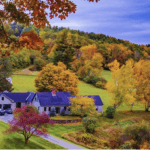What’s Shaping the Future of Vacation Rentals?
Table of Contents
Staying ahead of emerging Airbnb trends is challenging, though essential, for property managers and hosts who want to stay competitive in the rental market. During 2025, changes in guest preferences, technology, and sustainability will redefine the market.
What to expect in 2025?
The Airbnb market trends forecast for 2025 reflects a growing demand for personalized guest experiences, eco-conscious travel, and seamless property management solutions.

What are the Airbnb market trends shaping travel in 2025?
Trend 1: Focus on sustainability & eco-friendly rentals
Sustainability is one of the biggest Airbnb travel trends for 2025. Guests are prioritizing eco-conscious stays, seeking properties with renewable energy, built with sustainable materials, and that have the minimal environmental impact.
This is why lately properties with green certifications, solar power, and water-efficient solutions are in higher demand.
🔍 Insight: Properties that promote eco-friendly features see higher engagement and enjoy better booking rates. You should actively market these features to increase occupancy.
Pro Tip: Showcase eco-friendly amenities like solar panels, electric vehicle charging stations, or organic toiletries in your listing photos to target environmentally conscious travelers.
Trend 2: Increasing demand of serene and rural areas
The appeal of escaping urban environments is leading people to rural and off-the-beaten-path destinations. Airbnb booking trends reveal that travelers are gravitating toward stays close to nature (rustic cabins, farmhouses, and lakeside retreats) because these properties allow visitors to unwind and enjoy tranquil surroundings.
💡 Why it matters: Rural properties not only meet current preferences but also tend to have lower competition, which means you can make higher profits, especially for longer stays.
Pro Tip: Invest in professional photography and create immersive property descriptions to emphasize the unique qualities of your rural listing.
Trend 3: Property management services
The difficulties of managing multiple properties on Airbnb has led to a spike in demand for professional property management services. Tasks like dynamic pricing, guest communication, and operational logistics become more challenging the more properties you have, so you need expert support.
🔍 Why it matters: Property management services not only save you time but also help maximize revenue. Additionally, they smooth the guest experience .
Pro Tip: If you’re a property manager, thnk about leveraging tools like Hostify to automate key tasks, reduce workload, and boost guest satisfaction.
Trend 4: Streamlined booking processes
Travelers in 2025 expect an effortless booking process and personalized stays. From instant booking to AI-powered recommendations, simplifying the user experience is a priority in the short-term rental sector.
💡 Why it matters: Simplifying the booking process accelerates conversions and repeat guests. If you want to use this to your advantage, then use cutting-edge booking technology to remove frictions from the reservation process.
Pro Tip: Use a PMS with features like instant booking and automated guest communication.
Trend 5: Flexible cancellation options
Flexibility is a top priority for travelers. Guests prefer properties with accommodating Airbnb cancellation policies, because it helps them book with confidence. that is why properties with more relaxed terms rank higher in search results and have more frequent bookings.
🔍 Insight: Airbnb reports shows that flexible listings receive up to 20% more bookings compared to those with strict cancellation policies.
Pro Tip: Offer flexible cancellation options where possible, and highlight these in your property description to reassure potential visitors.
How to stay ahead of Airbnb trends in the upcoming year?
Property managers must go beyond simply watching trends and take proactive steps to adapt and excel. How?
- Go Green: Implement sustainable practices, invest in eco-friendly amenities and promote them in your property descriptions.
- Target the Right Locations: High-demand rural and off-grid properties that offer unique experiences.
- Leverage Technology: Use PMS tools to automate operations, improve efficiency, and have more time to offer better guest experiences.
- Provide Flexibility: Cater to traveler preferences and offer flexible booking and cancellation options.
- Work with Experts: Partner with professional property management platforms to navigate the ever-changing short-term rental market.
Airbnb booking trends – the new guest journey
One significant shift in guest journey is that more travelers are slow traveling, blending it with work and tourism experiences. Thanks to remote-work flexibility, the average number of nights per booking in the U.S. increased from 3.7 pre-pandemic to 4.1-4.4 after 2021.
Travelers are increasingly looking for more flexibility and personalization. What does it mean for PM and hosts? That they must make the best of every touch-point: discovery, booking, arrival, stay, and post-stay review.
Ensuring an excellent journey will drive higher conversions and better review sentiment.
Airbnb seasonality trends- how demand changes throughout the year
Hosts who understand how seasonality affects demand fluctuations throughout the year, have an edge over their competitors. Research from Europe shows that in 2024 about 33.6% of all guest nights in major short-term rental markets were recorded in July and August alone.
Winter: During winter the demand is often weaker in many destinations, still diffeent types of rentals like ski resorts, tropical escapes, or city breaks may be different.
What can hosts do? Promote winter-friendly properties: cozy interiors, fireplaces, winter sports access, and so on…besides adjusting pricing accordingly.
Spring: Spring tends to be a recovery time in the rental sector, with increasing searches, early summer bookings, and rising travel plans for holidays. Google Trends data indicate a spike in August 2025 searches for “vacation rentals” which may suggest late-summer/early-autumn interest as well.
Hosts with early bird offers or seasonal perks (fewer crowds, lower prices) can capture demand and ensure bookings during spring.
Summer: Summer is typically the peak season. One third of guest nights in some European markets concentrate in July-August.
If you manage properties in highly seasonal locations maximize pricing, ensure availability, and prepare for high turnover. Don’t allow oversupply during this period tank your occupancy rates.
Tailor amenities to the season (outdoor spaces, air-conditioning, family-friendly features) and target group bookings to increase productivity.
Fall: Fall can be considered a secondary peak period, especially for long-stay travelers and digital nomads. Savvy hosts can capture this demand by reframing their properties as “quiet luxury” or “extended stay” retreats.
If you market correctly, both pricing and occupancy can be somewhat similar to summer levels.
Stay Ahead with Hostify
Navigating the rapidly evolving Airbnb market trends can be challenging, but Hostify is here to help. Our all-in-one platform offers advanced solutions to streamline operations, manage multiple listings effortlessly, and boost your bookings.
With tools designed to improve efficiency and enhance guest satisfaction, Hostify empowers property managers to stay ahead in the competitive short-term rental industry. Whether you’re focused on scaling your portfolio or improving guest experiences, Hostify can help you achieve your goals. Book a Demo Today and discover how to dominate the vacation rental market in 2025 and beyond!








